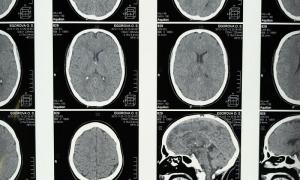Neocortex (brain): structure and functions
Since life appeared on Earth, a great diversity of structures and beings have appeared, evolved and died. Among the different beings that have lived and live on this planet the animal kingdom, to which we belong, it is one of those that has produced the greatest visibility, interest and debate in the imaginary collective.
In most of this kingdom it is possible to find one of the organs that makes possible our survival and the control of our organism and behavior: brain. In this organ, evolution has produced the appearance and development of various structures, many of them presenting a similar evolution in most chordate animals.
However, in some species a highly relevant structure has developed to a large extent to explain the ability to organize, reflect or have self-awareness, this structure being especially developed in higher primates and in us, the beings humans. This structure is the neocortex or neocortex.
What is neocortex?
The neocortex, neocortex or isocortex It is the structure that in humans makes up most of the cerebral cortex, specifically 90% of it
. It is the part of the brain with the most recent appearance at the phylogenetic level. It is mainly made up of Gray matter, that is, by somas (the "bodies" of neurons, where the cell nucleus is located) and dendrites of neurons that are part of the brain.Depending on the area, this structure is between two and four millimeters thick. Despite its small thickness, it is a large structure that due to its location within the skull must be condensed and folded, which is why the human brain has convolutions and curvatures. In fact, although the neocortex occupies roughly the area of a pizza in its folded state, deployed would occupy two square meters. The human brain is unique in the animal kingdom in terms of the ability to distribute many neuronal cells in a relatively small space.
Thus, the neocortex makes it possible for there to be a multitude of neurons distributed throughout several layers of Brain retracted in on itself, and this, in turn, has great benefits for our mental performance.
On the other hand, the neocortex is not a uniform structure, but is divided into the two cerebral hemispheres. In addition, the neocortex forms most of the different brain lobes, affecting the integration and consolidation of practically all the information that comes through the senses.
Its functions, then, are multiple and varied, as we will see below.
Principal functions
Taking into account that it makes up 90% of the cerebral cortex, it is logical to think that this part of the brain is of great importance in the normal functioning of the human being. But what functions does this area have that make it so important to us?
The neocortex or neocortex is considered the brain area responsible for our reasoning ability, allowing logical thinking and awareness. It is the area of the brain that allows all higher mental and executive functions (especially located in the frontal lobe). The Self and self-awareness are considered to be due to the functioning of this structure.
It is a set of neurons and glial cells whose function has nothing to do with giving a stereotypical and predictable response to certain stimuli, but rather work on content already processed by other nerve cells in order to "improvise" original responses in time real.
Reasoning, reflection, decision making ...
Also the neocortex serves as an area of association and integration of the different perceptions and awareness of these, helping to form a more accurate mental image of reality. It allows in-depth analysis of information, reflection and the ability to decision making.
It is the part of the brain that allows planning and anticipation of results, recreating possible scenarios and allowing based on this the establishment of a strategy or conduct to follow, continue.
Skills such as calculation and language also depend on the neocortex, requiring the integration of different information and its transformation in different areas of this structure. In the same way, long-term memory also depends to a great extent on the neocortex, being the area where it is "Records" the new information and from which it is taken to the working memory in order to be able to operate with it.
It also allows the development and optimization of the remaining parts of the brain, being able to control the behavior, manage emotions and inhibit non-adaptive behavior patterns, as well as record and consolidate new.
At the social level, the neocortex also has a fundamental role, since thanks to it it is possible to control and manage impulses, emotions and behaviors. This implies that it allows the existence of consideration for others, the negotiation of goals and, in general, the coexistence with other members of our same species.
Layer organization
In addition to its functional division into the different brain lobes and in two hemispheres, it is necessary to take into account that the neocortex does not have a homogeneous composition in all its extension.
In fact, this part of the brain is divided into six different layers mainly due to the type and organization of the nerve cells that are found in them.
Layer I: External plexiform layer
Also called molecular layer, it is the outermost and superficial layer of the neocortex, being covered by the pia mater (one of the meninges). This first layer contains relatively few neurons.. It is responsible for receiving fibers from various brain systems that send information of different types from various parts of the central nervous system.
Its composition is mainly based on horizontal Cajal cells, dendrites of different types of neurons and interneurons and some axons of cells of other inner layers and of structures such as the thalamus. It is a layer that functions as an association layer at the intracortical level, that is, it integrates different types of information creating larger and more significant units.
Layer II: Outer granular or small pyramidal cell layer
This layer of the neocortex is composed mainly of pyramidal and stellate cells. (star-shaped), whose dendrites are located in the outer plexiform layer and axons in lower layers. Like the previous one, it serves as an association mechanism between the different parts of the cortex, although at another level.
Layer III: Outer pyramidal layer
Composed mainly of pyramidal cells of variable size, although generally superior to that of the external granular layer. The axons of these configure projection and association fibers. It serves as an intracortical association area. Also, some of its neurons they project contralaterally (to the other hemisphere of the brain), so that a bridge is established between these two halves of the upper part of the central nervous system.
Layer IV: Inner granular layer
This layer is mainly composed of star-shaped cells. This layer does not exist in some areas, as in the motor cortex. It receives information from the thalamus, which is distributed by this layer in what is known as thalamocortical striae. Its fibers are projected to the basal ganglia, spinal cord and Brain stem.
Layer V: Internal pyramidal or ganglionic layer
The fifth layer of the neocortex is made up of large pyramidal cells, along with other stars, which send information to other areas of the brain. Within this layer you can see Baillarger's band, a grouping of nerve fibers located horizontally and that can be distinguished from the adjacent areas that make up the neocortex.
Layer VI: Polyform layer
Formed by cells of irregular and polymorphic shapes, this layer of the neocortex performs efferent functions, sending connections to the white matter and many of its neurons traveling through the corpus callosum. That is, it sends information to relatively remote areas, more than it receives directly from them.
Bibliographic references:
- Hall, J. (2011). Guyton and Hall textbook of medical physiology. Philadelphia: Saunders / Elsevier.
- Jerison, H.J. (1991). Fossil brains and the evolution of neocortex. In Finlay, B.L.; Innocenti, G. & Scheich, H. (eds.). The neocortex. Ontogeny and phylogeny. New York: Ed. Plenum Press; p. 5-19.
- Kandel, E.R.; Schwartz, J.H. & Jessell, T.M. (2001). Principles of neuroscience. Madrid: McGraw Hill.
- Lewis, W.B. (1978). On the comparative structure of the cortex cerebri. Brain; 1: 79-86.
- Morgan, A.J. (2001). The evolving brain. Editorial Ariel neuroscience.



